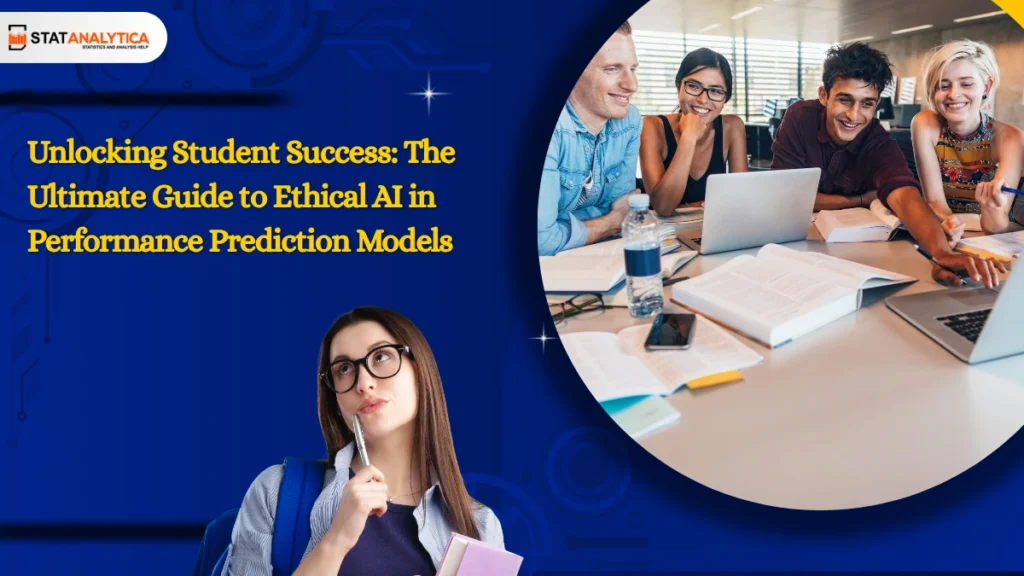The digital revolution is sweeping through education, bringing with it a powerful tool that promises to revolutionize how we understand, support, and guide students: Artificial Intelligence (AI). Specifically, student performance prediction models—AI systems designed to forecast a student’s academic trajectory, identify those at risk of dropping out, or pinpoint learning gaps—are quickly becoming central to institutional strategy. These models hold the phenomenal potential to create truly personalized and equitable learning pathways.
However, with this immense power comes an equally immense responsibility. The ethical considerations are not merely footnotes; they are the bedrock upon which the entire system must be built. The success of this new era hinges entirely on our commitment to AI ethics in student performance prediction models.
This definitive, in-depth guide is designed to empower educators, administrators, policymakers, and students to navigate the moral landscape of ethical AI in education, ensuring that technology serves as a powerful force for good—driving unprecedented student success while upholding the highest standards of fairness, transparency, and data privacy.
The Astonishing Potential of Predictive AI in Education
Table of Contents
The deployment of predictive analytics marks a monumental leap forward from traditional, retrospective data analysis. Instead of looking backward at what has happened, AI allows us to look forward, providing educators with a kind of academic “early warning system.”
Transforming Learning Pathways
The core benefit of these models lies in their ability to facilitate personalized learning experiences.
- Early Intervention: AI models analyze diverse data points—attendance, engagement in the Learning Management System (LMS), assignment scores, and demographic information—to identify students likely to struggle before they fall behind. This allows advisors and faculty to initiate timely, targeted interventions, turning potential failure into guaranteed success.
- Resource Optimization: Institutions can strategically allocate resources, such as tutoring services, mental health support, or financial aid counseling, to the students who will benefit the most, maximizing the impact of limited budgets.
- Curriculum Refinement: By aggregating prediction data, educators gain actionable insights into which courses or assignments present the most significant hurdles, allowing for continuous and effective curriculum improvement.
Navigating the Ethical Imperative: The Core Pillars of AI Ethics in Student Performance Prediction Models
While the benefits are clear, the ethical pitfalls are serious and must be proactively addressed. Ignoring these challenges risks exacerbating existing inequalities and eroding student trust. Our approach to AI ethics in student performance prediction models must be guided by four foundational pillars: Fairness and Bias Mitigation, Data Privacy and Security, Transparency and Explainability, and Accountability.
Pillar 1: Fairness and Bias Mitigation
This is arguably the most critical and complex challenge. Predictive models learn from historical data, which often reflects existing systemic and societal biases.
The Danger of Algorithmic Bias
If a model is trained on data where, historically, students from certain low-income backgrounds or specific racial groups received less support, the model may incorrectly “learn” that these groups are inherently less likely to succeed. This is algorithmic bias, and it can lead to a self-fulfilling prophecy where the AI perpetuates and amplifies educational inequity.
- Example: A model might flag students based on zip code (a proxy for socioeconomic status) as “high-risk,” leading to more intrusive monitoring and less academic freedom, while an equally struggling but privileged student is simply offered an “optional” academic coach.
- Best Practice for Fairness: Implement a Bias Audit Framework from the start. This involves testing the model’s prediction accuracy across different demographic groups (e.g., race, gender, socioeconomic status) and employing de-biasing techniques—such as adjusting data weights or using fairness-aware algorithms—to ensure that the model is equally accurate and fair for all students. The goal is to correct historical disadvantages, not encode them into the future.
Pillar 2: Data Privacy and Security
Predictive models are data-hungry. They ingest vast quantities of sensitive student data, creating significant concerns about student data privacy and security.
Protecting Sensitive Student Information
Educational data can include grades, health records, disciplinary history, LMS activity logs, and even biometric information from online proctoring—all protected under laws like FERPA (in the US) or GDPR (in the EU).
- Informed Consent: Students (or their guardians) must provide explicit, informed consent for their data to be used in these models. Consent cannot be a buried clause in a massive terms-of-service agreement; it must be clear, understandable, and allow for opt-out where feasible.
- Data Minimization: Only collect and use the data that is strictly necessary for the predictive task. The principle of data minimization reduces the overall risk profile.
- Robust Security: Institutions must use state-of-the-art encryption, access controls, and regular audits to protect data from breaches or unauthorized commercial use. Secure practices in learning analytics and student data privacy build essential trust.
Pillar 3: Transparency and Explainability
If an AI flags a student for intervention, that student and their support staff must be able to understand why. This is the core challenge of the “black box” problem.
The Imperative of Explainable AI (XAI)
A prediction is only useful if it is actionable. A student being told “the AI thinks you will fail” without context is demoralizing and unhelpful.
- Clear Rationale: Models must be designed with Explainable AI (XAI) principles, providing a human-readable rationale for the prediction (e.g., “The model’s prediction is driven primarily by low engagement with the last three homework modules and below-average scores on the mid-term exam, which historically correlate with a high DFW rate in this course”).
- Transparency in Model Use: The institution must be fully transparent about where, when, and how AI models are being used to make or inform decisions. This includes disclosing the key input variables and the decision-making thresholds. Trust is built on transparency.
Pillar 4: Accountability
Who is responsible when a predictive model makes a mistake, or worse, leads to a discriminatory outcome?
Human Oversight and Governance
Ethical AI in education mandates a clear line of human accountability. The technology can inform, but it must not replace human judgment.
- Human-in-the-Loop: A human educator or advisor must always review the AI’s prediction before any decision is implemented. The model’s output is an alert, not a final verdict.
- Governance Structure: Establish an AI Ethics Review Board composed of faculty, administrators, students, and technology experts to continuously monitor, evaluate, and audit the performance and fairness of all deployed predictive models. This ensures that the system is accountable to the educational mission.
Implementing a Victory Framework: Best Practices for Ethical Deployment
Creating a framework for responsible AI in student prediction requires a holistic, long-term commitment that focuses on collaboration and continuous improvement.
| Best Practice Area | Action Steps for Ethical AI Integration | Target Outcome |
| Data Integrity | Conduct continuous data audits for quality, consistency, and completeness; actively search for and remove biased features (or proxies). | Ensure the model learns from a fair and representative past. |
| Model Testing | Test models rigorously using Fairness Metrics (e.g., equal opportunity, demographic parity) before deployment; simulate impact on marginalized groups. | Guarantee predictions are equally accurate and fair across all student demographics. |
| Student Agency | Design interventions to be supportive and empowering, not punitive or deterministic. Give students a voice in how the data is used to help them. | Foster student trust and encourage engagement with personalized support. |
| AI Literacy | Provide comprehensive training for faculty, staff, and students on how the models work, their limitations, and the ethical principles governing their use. | Create an informed, critical community capable of overseeing AI use. |
| Policy & Legal | Develop clear, publicly accessible institutional policies that align with FERPA, GDPR, and principles of educational equity. | Mitigate legal risk and solidify the institution’s ethical commitment. |
Cultivating an Unstoppable Culture of AI Literacy
The most effective ethical safeguard is an informed community. AI literacy must become a core competency for both students and staff. Educators should be trained not just on using the AI tools, but on critically evaluating the output, questioning the data sources, and understanding the potential for bias. Students should learn about AI’s role in academic outcomes so they can become active, informed partners in their own personalized learning journey.
The Brilliant Future of Ethical AI in Education
The journey to ethically integrate AI into student performance prediction models is challenging, but the potential rewards—unparalleled student success, truly equitable education, and optimized institutional efficiency—are simply too great to ignore.
By prioritizing AI ethics in student performance prediction models through unyielding commitments to fairness, privacy, transparency, and accountability, we don’t just mitigate risk—we unleash a powerful, positive transformation in education. We move beyond simply predicting performance to actively shaping and securing a brighter future for every single student.
The era of responsible AI in education isn’t coming; it’s here. Let’s embrace it with wisdom, diligence, and a shared mission to unlock the full, magnificent potential of every learner. The success of the next generation depends on the ethical choices we make today.
Also Read: From Theory to Practice: Hands-On AI Courses You Can’t Miss in 2025


